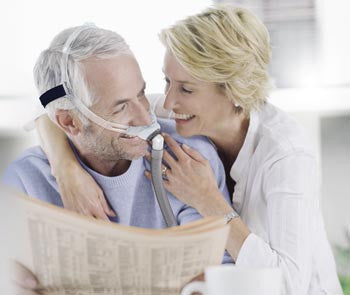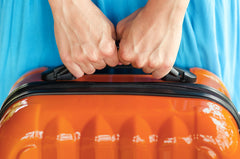How do you know what type of CPAP mask would best fit your needs while treating your obstructive sleep apnea? At My CPAP Club, we offer two types of masks for CPAP therapy, including:
 Using the right mask is essential to the success of your treatment. You need a mask that is comfortable and fits properly. It should form a good seal on your face so that air doesn't leak (this would be uncomfortable and make your therapy less effective). A nasal mask that covers the nose is the most common choice among individuals suffering from obstructive sleep apnea.
Using the right mask is essential to the success of your treatment. You need a mask that is comfortable and fits properly. It should form a good seal on your face so that air doesn't leak (this would be uncomfortable and make your therapy less effective). A nasal mask that covers the nose is the most common choice among individuals suffering from obstructive sleep apnea.
However, some people breathe through their mouth when they sleep. In this case, a full face mask that covers both the nose and mouth is the best option. Another option would be a nasal mask and chinstrap, which will prevent the jaw from opening during sleep and still provide you with effective CPAP therapy.
If you are still unsure of what CPAP mask is the right option for you, contact My CPAP Club today at 1-888-272-7050. We would be happy to explain our different mask types and answer any questions you may have.
Maintaining a nightly schedule with your CPAP machine and mask is sometimes difficult. So, what if you add to that the fact that you travel a lot? My CPAP Club is here to give you some tips about CPAP travel and how you can make treating your obstructive sleep apnea (OSA) on-the-go as easy as possible.
 It is important to remember that if you suffer from OSA, every time you sleep, your airway is obstructed and your oxygen drops, while your heart, brain, lungs and other bodily systems are strained. This is why we recommend you continue your CPAP therapy whenever – and wherever – you sleep, even if you are just going out of town for one or two days.
It is important to remember that if you suffer from OSA, every time you sleep, your airway is obstructed and your oxygen drops, while your heart, brain, lungs and other bodily systems are strained. This is why we recommend you continue your CPAP therapy whenever – and wherever – you sleep, even if you are just going out of town for one or two days.
Here are some tips for flying on an airplane with your CPAP mask or machine:
If you are planning a camping trip or spending a lot of time on the road, we recommend following these tips for dealing with your CPAP machine:
If your doctor has determined that you have sleep apnea, then he or she probably recommended continuous positive airway pressure (CPAP) as a possible treatment. Perhaps you’ve tried CPAP before and found the mask too uncomfortable to allow you to sleep. Not to worry, My CPAP Club is here to provide the information you need, so that you can get back to sleeping soundly the whole night through.
When it comes to selecting the right mask, you have three main categories to choose from: nasal mask, full face mask and nasal pillow mask. Within these categories, there are additional modifications and features to provide even more comfort. The first step, however, is deciding which category of mask is the best fit for you — not just size, but sleeping and breathing style, as well.
 Nasal Mask
Nasal MaskIf you breathe through your nose while sleeping, then a nasal mask could be the best option for you. However, it’s worth keeping in mind that a nasal mask can be less effective when you are experiencing allergies or nasal blockage due to a cold. If you are prone to allergies and other sinus-related issues, you might want to consider a full face mask.
A nasal mask is triangular in shape, designed to form a seal around your nose. The mask is held in place by two straps that connect at four different points to provide a secure and snug fit.
Do you generally breathe through your mouth when asleep? If so, a full face mask is the one for you. This mask is also the best option for people who commonly suffer from allergies, sinus infections or other nasal blockages. By fitting around both your nose and mouth, a full face mask provides the most efficient and effective sleep apnea therapy by preventing mouth leaks and ensuring regulated pressure throughout the night.

Full face masks are also triangular in shape, but cover both the mouth and nose. To ensure a secure fit, the mask is held in place by four point headgear, one strap wrapping around the forehead and the other around the jaw and base of the head. The addition of a chin strap prevents the jaw from opening during sleep, which further improves the effectiveness of your CPAP machine.
For users with facial hair or those who simply don’t like the feeling of so much gear on their face, a nasal pillow mask offers minimal contact points on the face. It also provides a clear line of vision, so that you can read a book or watch television before bed. Keep in mind that this mask only works for people who breathe through their nose.
A nasal pillow mask seals at the bottom of your nostrils, with a flexible pillow to provide comfort. A single, thin strap connects at two points and adjusts at the back of your bed, running just over the top of your ears.
Using the right mask is essential to the success of your treatment. You will need a mask that is comfortable and fits properly. If it’s uncomfortable, you’ll be less inclined to use it. And if it the fit isn’t snug and secure, air could leak out, making your therapy less effective.
Remember that good sleep is necessary to functioning at your most productive level. If you don’t find the right mask on your first try, don’t be discouraged. Contact My CPAP Club to learn more about CPAP masks and which one might be the best fit for you.